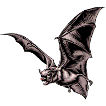Museum, University of Nebraska State
Document Type
Article
Date of this Version
12-27-1978
Citation
Bulletin of the Carnegie Museum of Natural History (December 27, 1978) 12: 1-53.
Abstract
Nongeographic and geographic variation have been analyzed in the genus Brachyphylla. which belongs to the Antillean endemic subfamily Phyllonycterinae of the family Phylloslomatidae. Males were found to be generally larger than females: therefore, the sexes were analyzed separately for geographic variation. External measurements except length of forearm were found to displaya high degree of individual variation. They were not used in subsequent analyses. Of cranial measurements, greatest length of skull and condylobasal length showed the least individual variation, whereas palatal length, postorbital breadth (in samples from west of the Mona Passage only), and rostral width at canines showed relatively high coefficients of variation. Variation in color was found not to follow any geographic pattern.
Two species-Brachyphylla cavernarum and B. nana-were recognized in the genus. B. cavernarum occurs on Puerto Rico. the Virgin Islands, and the Lesser Antilles as far south as St. Vincent. Three subspecies are recognized. Populations of large bats occur on St. Croix in the Virgin Islands and the Lesser Antilles as far south as St. Vincent. The smallest individuals occur only on the island of Barbados. Populations of bats of intermediate size, described herein as a new subspecies, occur on Puerto Rico and most of the Virgin Islands. Brachyphylla now is a monotypic species occurring on Cuba, Isle of Pines, Grand Cayman, Middle Caicos, and Hispaniola and as a sub-Recent fossil on Jamaica.



Comments
Copyright 1978, Trustees of Carnegie Institute. Used by permission.